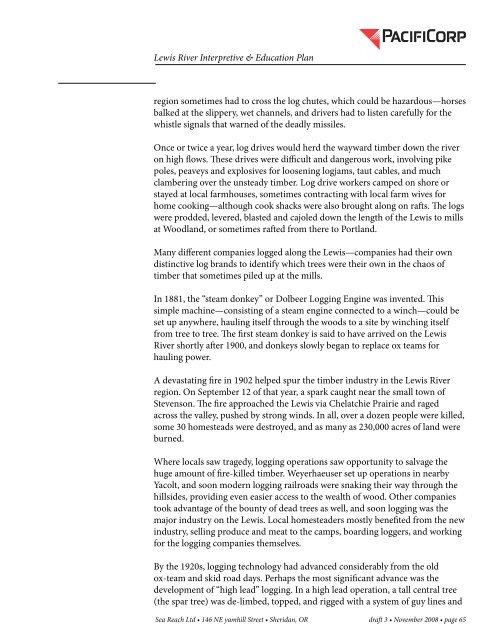The Lewis River Hydroelectric Projects - PacifiCorp
The Lewis River Hydroelectric Projects - PacifiCorp
The Lewis River Hydroelectric Projects - PacifiCorp
Create successful ePaper yourself
Turn your PDF publications into a flip-book with our unique Google optimized e-Paper software.
<strong>Lewis</strong> <strong>River</strong> Interpretive & Education Plan<br />
region sometimes had to cross the log chutes, which could be hazardous—horses<br />
balked at the slippery, wet channels, and drivers had to listen carefully for the<br />
whistle signals that warned of the deadly missiles.<br />
Once or twice a year, log drives would herd the wayward timber down the river<br />
on high flows. <strong>The</strong>se drives were difficult and dangerous work, involving pike<br />
poles, peaveys and explosives for loosening logjams, taut cables, and much<br />
clambering over the unsteady timber. Log drive workers camped on shore or<br />
stayed at local farmhouses, sometimes contracting with local farm wives for<br />
home cooking—although cook shacks were also brought along on rafts. <strong>The</strong> logs<br />
were prodded, levered, blasted and cajoled down the length of the <strong>Lewis</strong> to mills<br />
at Woodland, or sometimes rafted from there to Portland.<br />
Many different companies logged along the <strong>Lewis</strong>—companies had their own<br />
distinctive log brands to identify which trees were their own in the chaos of<br />
timber that sometimes piled up at the mills.<br />
In 1881, the “steam donkey” or Dolbeer Logging Engine was invented. This<br />
simple machine—consisting of a steam engine connected to a winch—could be<br />
set up anywhere, hauling itself through the woods to a site by winching itself<br />
from tree to tree. <strong>The</strong> first steam donkey is said to have arrived on the <strong>Lewis</strong><br />
<strong>River</strong> shortly after 1900, and donkeys slowly began to replace ox teams for<br />
hauling power.<br />
A devastating fire in 1902 helped spur the timber industry in the <strong>Lewis</strong> <strong>River</strong><br />
region. On September 12 of that year, a spark caught near the small town of<br />
Stevenson. <strong>The</strong> fire approached the <strong>Lewis</strong> via Chelatchie Prairie and raged<br />
across the valley, pushed by strong winds. In all, over a dozen people were killed,<br />
some 30 homesteads were destroyed, and as many as 230,000 acres of land were<br />
burned.<br />
Where locals saw tragedy, logging operations saw opportunity to salvage the<br />
huge amount of fire-killed timber. Weyerhaeuser set up operations in nearby<br />
Yacolt, and soon modern logging railroads were snaking their way through the<br />
hillsides, providing even easier access to the wealth of wood. Other companies<br />
took advantage of the bounty of dead trees as well, and soon logging was the<br />
major industry on the <strong>Lewis</strong>. Local homesteaders mostly benefited from the new<br />
industry, selling produce and meat to the camps, boarding loggers, and working<br />
for the logging companies themselves.<br />
By the 1920s, logging technology had advanced considerably from the old<br />
ox-team and skid road days. Perhaps the most significant advance was the<br />
development of “high lead” logging. In a high lead operation, a tall central tree<br />
(the spar tree) was de-limbed, topped, and rigged with a system of guy lines and<br />
Sea Reach Ltd • 146 NE yamhill Street • Sheridan, OR draft 3 • November 2008 • page 65
















